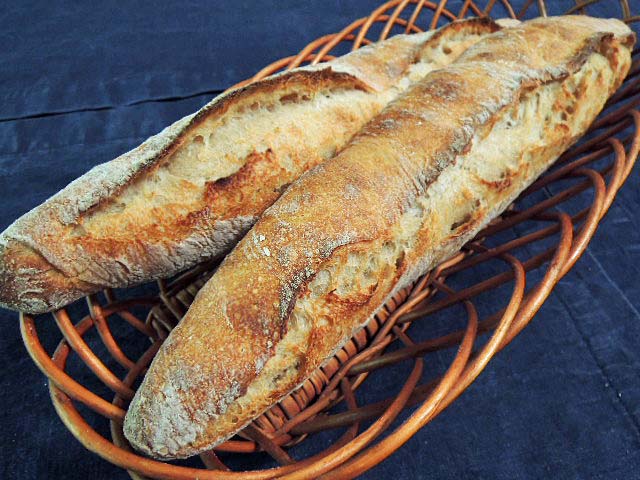
I have made baguettes following many different formulas. Some of the most interesting have been various versions of “pain à l'anciènne,” including those of Reinhart in The Bread Baker's Apprentice and of Leader in Local Breads. Sometime back in 2008, I found an e-mail that Peter Reinhart had sent to a bread bakers' Usenet mailing list in 2003 which described the formula for pain à l'anciènne as he got it directly from Philippe Gosselin. The version that ended up in BBA was simplified somewhat by Reinhart, adding all the ingredients before the mixing, omitting the double hydration and delayed addition of the salt.
When I first made baguettes from Gosselin's original method, they were the best-tasting ones I had ever made. I finally got to taste Gosselin's baguettes tradition (from the rue Caumartin shop) last year. To my taste, they had a bit of a tang suggesting they might have been made with levain, so I modified the formula to use a liquid levain and found I preferred the result to that leavened with commercial yeast. In fact, I preferred what I had baked to Gosselin's own.
This is the version I used for today's bake:
Ingredients | Wt. | Baker's % |
Organic AP Flour | 400 g | 100 |
Ice Water | 275 g | 69 |
Salt | 8.75 g | 2 |
Liquid Levain | 200 g | 50 |
Instant yeast (optional) | ¼ tsp | |
Total | 883.75 g | 221 |
Notes: Accounting for the flour and water in the levain, the total flour is 500 g and the total water is 375 g, making the actual dough hydration 75%. The actual salt percentage is 1.75%.
For today's bake, I made 3/4 of the dough amount in the table above.
I mixed the levain the night before starting on these and retarded it in the fridge overnight.
Method
The night before baking, mix the flour and levain with 225 g of ice water and immediately refrigerate.
The next morning, add the salt and 50 g of ice water to the dough and mix thoroughly. (I did this by hand by squishing the dough between my fingers until the water was fully incorporated.)
Place the dough in a lightly greased bowl with a tight cover.
Ferment at room temperature until the dough has about doubled in volume. (3 hours for me) Do stretch and folds in the bowl every 30 minutes for the first two hours.
An hour before baking, pre-heat the oven to 500ºF, with baking stone and steaming apparatus in place.
Divide the dough into 4 more or less equal pieces and stretch each into a 12-14 inch long “baguette.”
Score and bake immediately at 460ºF, with steam for 10 minutes, and for about 20 minutes total.
Cool on a rack before eating.
Notes: In Step 7., I specify shaping the loaves by simply stretching the dough pieces into a rough baguette shape. This is a very slack dough and a challenge to handle as one might a lower-hydration baguette dough. If you are very comfortable handling slack dough, have a firm grasp of the “iron hand in a velvet glove” principal and are feeling up to the challenge, you can shape the pieces as you would shape a baguette ordinarily. That is, in fact, what I did for this bake.
You will also note that I scored these baguettes with a single, longitudinal slash. I find the results more satisfactory than the traditional 5 or 7 cuts when scoring a very sticky dough like this. However, the difference is merely cosmetic.




These baguettes had a chewy crust, except for the ears, which were crunchy. I think they could have baked 5 minutes longer, or I could have left them in the turned off oven for another 5-7 minutes to dry the crust. The crumb was nice and open. The flavor was sweet, complex and moderately tangy. I attribute this to a combination of factors – retarding the levain overnight and fermenting the dough, after the final mixing, at 85 dF.
This baguette is still a favorite.
David
Submitted to YeastSpotting